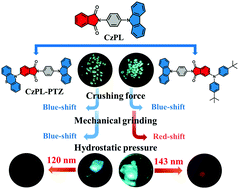Asymmetric D–A–D′ Scaffold inducing distinct mechanochromic luminescence†
Abstract
Mechanochromic luminescence (MCL) materials have a high requirement in high-tech applications such as pressure sensors and data storage. Nevertheless, the diversity of these emitters is rather restricted owing to the lack of clear molecular structure design guidelines, and it is imperative to develop creative multi-stimulus responsive compounds with polychromatic emission under different types of mechanical forces. In order to overcome difficulties of a single molecule exhibiting obvious MCL responses towards mechanical forces, in this study, a powerful approach of distinct multi-stimulus responsive MCL materials is to integrate the distinguished ability of donor units (D′), i.e. stronger phenothiazine (PTZ) and weaker bis(4-(tert-butyl)phenyl)amine (tDPA) compared with 9H-carbazole, directly into the same donor–acceptor (D–A) scaffold of 2-(4-(carbazol-9-yl)phenyl)-isoindoline-1,3-dione (CzPL) and hence obtaining CzPL-PTZ and CzPL-tDPA. Distinct MCL were primarily found for the parent CzPL-PTZ and CzPL-tDPA crystals under tensile force, and anisotropic and isotropic pressures. Interestingly, both crystals show an abnormal blue-shifted emission under crushing force. When under anisotropic pressure, the CzPL-PTZ ground sample further displays blue-shifted emission, but the CzPL-tDPA ground sample displays red-shifted emission. In contrast, both parent crystals show a similarly red-shifted and weakened emission under increasing isotropic pressure. Furthermore, these emissions exhibit a linear relationship between wavelength and pressure. More importantly, crystal CzPL-PTZ can completely return to the initial state once decompressed due to the reversible 3D short-range intermolecular interaction network; in contrast, the crystal CzPL-tDPA cannot fully recover to its original state after removing pressure due to the lattice vibration under a high pressure. The interesting and distinct MCL behaviors of CzPL-PTZ and CzPL-tDPA indicate that the D–A–D′ molecular design should provide pragmatic insights towards MCL materials.

- This article is part of the themed collections: Popular Advances and Fluorescent and Luminescent Materials


 Please wait while we load your content...
Please wait while we load your content...